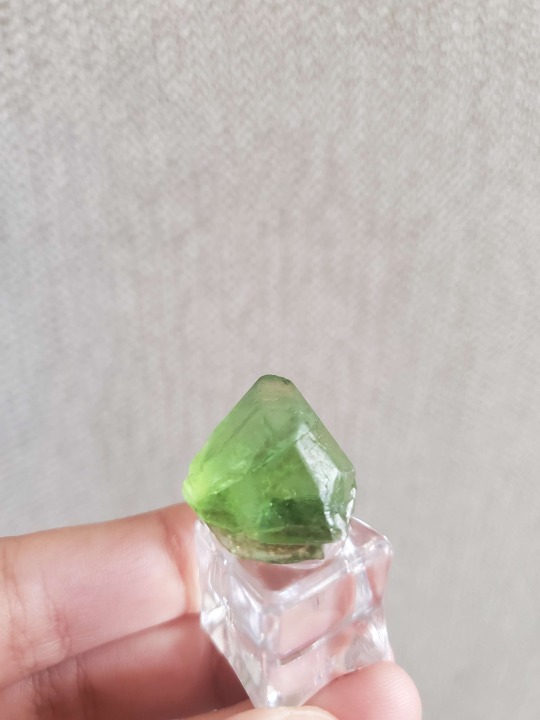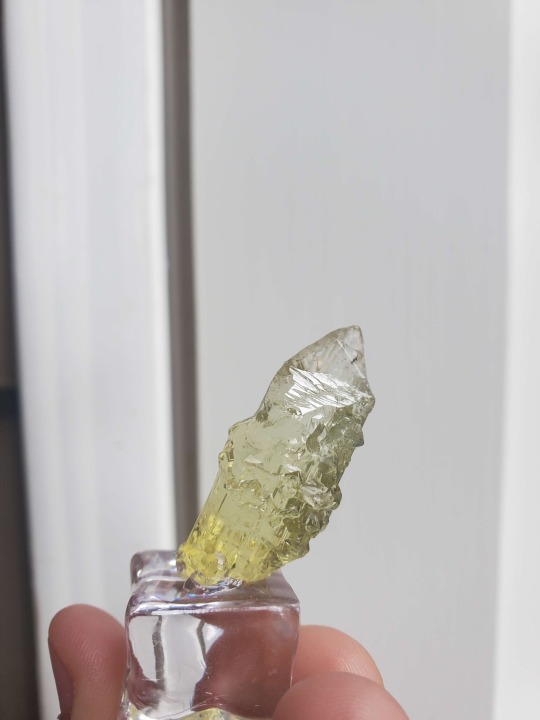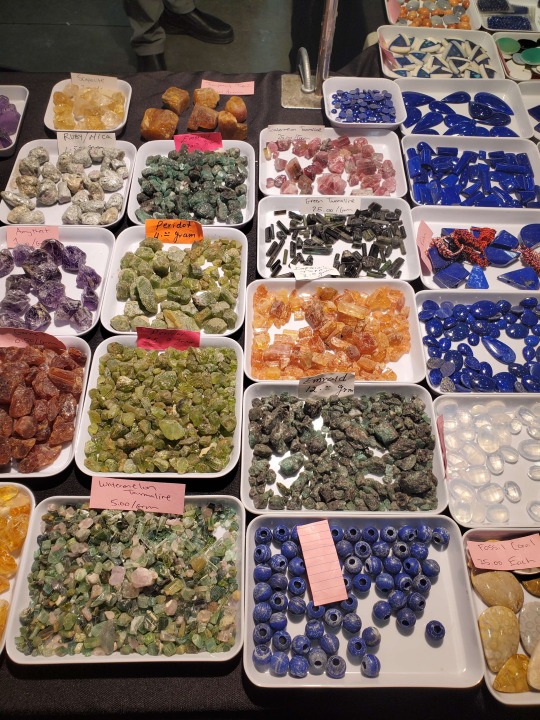The adventures of a developing hobby, throughout the years.
Don't wanna be here? Send us removal request.
Text
The third encounter
The next gem show that came along was decidedly less impressive. Not outright bad, but the bad vendors got bolder, and the good ones weren’t doing much better. Obvious fakes, perfect alexandrites that would be worth five figures yet didn’t have proper lab reports, had oblivious attendees scrambling to take their pick, convinced they were getting a good deal. The stones that were real were poorer in quality, and lacked the luster that made them so attractive in the first place. Pseudoscience must’ve gotten popular, as many of the tables were occupied by ladies wearing tie-dye shirts claiming that obsidian could “unblock your chakra”, or something along those lines.
It took half the time to get through each vendor compared to last year’s, and by the end I was ready to leave early and go to a restaurant for lunch with the money I originally set aside to use at the show.
“I think we missed a few up front, why don’t we walk back there and see what they have?” My friend was there to accompany me, though she had no interest in gems herself. It was a weak, though genuine, attempt at trying to make me feel better.
“I suppose it wouldn’t hurt,” I answered with a shrug. If anything, it would be a waste to leave so early when the entry ticket was valid for the whole day.
Just like she said, up front was a smaller table hidden behind a concrete pillar. Presentation wasn’t his strong suit, but that wasn’t particularly important, because anyone with a trained eye could still appreciate the quality of his specimens. And by that point, I had trained well.
I pressed my finger to the glass cabinet. “Could you show me this heliodor, please? And that peridot, the one on the left.”
Once they were out of the cabinet, I looked under their display mounts to check their size and price. My friend whistled.
“That yellow one’s expensive,” she said.
“Actually, it’s reasonable. This one’s from Ukraine, and the mines there are known for producing the best heliodor specimens.” Still, even a reasonably priced heliodor was expensive. Even a small one went out of my budget. With the added price of the peridot, it was just too much.
Unlike most of the other tables, this one didn’t have a line to view it. In fact, hardly anyone was around at all. So I decided to try my luck, and whispered to my friend about my newly hatched plan.
In a louder voice, I exclaimed, “This one has an excellent shape, and… oh, but there are some impurities in it. And the peridot has a crack running through the base.”
“Yes, why don’t we keep looking?” My friend responded.
That managed to get the vendor’s attention. “Hold on a minute. These specimens… why don’t I give you a discount? 20% off.”
“I don’t know, it might not be what we’re looking for with our budget,” I told him.
“What about 30%?”
30% was as good of a deal as I was going to get. Budget be damned. “Deal.”
Before I could reach for my wallet, my friend had already tapped her credit card to complete the purchase, and the vendor was getting everything bagged up. “Why did you do that?” I asked.
She laughed. “You seemed down. Consider it an early birthday gift.”
Free stuff was better than a discount, but a gift from someone was the most special thing of all.


0 notes
Text
The second encounter
The jar with the piece of dried clay stayed on the shelf for several years after that. It became a frequent object of attention whenever I had a point to make. An easy thing to bring up and say, “I told you so!”
The jar remained, but my tastes changed. I still liked free stuff –who didn’t?-- but at the same time, there was an undeniable appeal to things that were sold in shops. And things that were appealing carried heavy price tags.
So the jar remained on the shelf, though mostly forgotten about at that point. My affinity for things coming from the earth remained, and only grew more picky. With the power of the internet, it was easy to grow more proficient in identifying rocks and minerals, though I was nowhere near perfect. The best way to learn was to be hands-on, and that opportunity did not reveal itself to me until years later, when an annual gem show announced it would be hosting its first event since the pandemic shut everything down. Vendors from all over the country would be there, and they had student discounts for entry tickets, so really, how could one resist?
The venue was huge. Each vendor had their own table set up, some with two, to showcase all their goods. When lined up neatly, each row seemed to stretch on forever, which was a good thing considering how many people were there. Even with so many options, some tables were so popular that lines of people would filter in and out of the main viewing sections, taking turns to look at the displays of sparkling sapphires, rubies, and garnets. Most were already cut and polished, ready to be set in a ring or a pendant, and cheaper materials like quartz were sold as tumbled stones and cabochons to anyone just getting into the hobby who weren’t ready to commit to bigger purchases. None interested me; I wasn’t looking for anything already changed by man to fit into artificial standards of beauty. The ones that were carefully preserved the way they were when they were first mined were the ones that were truly beautiful.
There was one man who sold precisely that, at a table tucked away in a corner at the very end of the venue. He wore only a sleeveless vest that could’ve at one point been bright white, but was now yellow from sweat stains. He was speaking to another man of similar middle age, and neither paused their conversation when I approached to inspect his inventory.
He seemed to appreciate the unordinary. The one specimen that eventually caught my eye was a piece of hematite with yellow-brown rutile needles emerging from its sides. Rutile in itself was a controversial mineral; its needle-like structure mainly grew in other gemstones, and depending on its placement, could either drive down the value of the specimen or greatly increase it. In this case, it was definitely the former.
The man finally took notice of my presence, and let out a hum of approval when I let him know what I wanted. “That there’s a fine piece of rutile, little lady. Got it myself from a supplier in Tucson earlier this year.”
“Yes, the colour on this one is particularly attractive.” Some valuable advice I got from the internet: acting hard to please didn’t work in the gem industry. Showing interest was far more effective in getting a good deal, in the end.
“Tell you what, miss. I’ll give you a discount this time, since you looked so interested in it.”
I smiled. “Thank you, sir.”
Not quite free, but it was hard to argue with a discount.


0 notes
Text
The first encounter

The Gobi Desert was dry, as expected.
Each gust of wind sent loose grains of sand scattering across endless dunes. When it did, it was blinding, and the only way to retain vision was to squint and hope you got lucky with your genes to have long eyelashes. Luckily, I did, and so I squinted and navigated my way through the area with relative ease while the rest of my group was left stumbling around like blinded cattle.
Our tour guide parked the Jeep just off the dirt road, intent on taking a break after driving all day, and for us tourists to take pictures and let the kids run around and get their energy out. I was one of those kids, the second youngest out of six, but playing games with the older kids was the last thing on my mind. Roughhousing didn’t sound appealing at all when there was new territory to explore.
The desert was not all sand, but it was all rock. It just happened to take different forms, from the countless grains of sand to the big red rocks, some smoother than others due to millions of years of erosion and weathering. I was not the only one to have taken an interest in it, as my mother was soon out of the Jeep with a glass jar in hand.
“What’s that for?” I asked with typical childlike curiosity.
“We’re going to collect sand,” she explained while using her free hand to shield her eyes. “Buying cheap souvenirs when we’re back in the city would be such a waste. Collecting something authentic sounds much more fun, don’t you think?”
I nodded. This wasn’t anything new coming from her, so it was hardly surprising. One quick glance at the back of the Jeep would reveal all the other times she went souvenir hunting during our trip: Yak pelts piled way up high, bought from nomads passing through with their herds trailing behind them; neatly folded scarves and sweaters made of Mongolian cashmere as they were “the warmest in the world”, despite the temperature in our hometown never quite making it into the single digits even on the coldest winter day.
“Can I bring this home?” I asked when I found something deemed worthy enough to put in the jar. It was a single piece of dried clay, broken into a uniform shape, but otherwise having no notable qualities to speak of. If this were anywhere but the Gobi Desert, it would just be mud, worth nothing more than a frustrated groan if one were to accidentally step in it. But at that moment it was dry enough to hold, and it didn’t crack even after being handled, so to me it was perfect.
My mother was not as easily convinced. “You do realise that the moment we get home, the moisture will ruin it?”
“Not if we seal the jar really tight,” I tried to argue back.
“...Alright. We can bring it back,” she said, though the wrinkle in her forehead and tight-lipped mouth remained.
“Great! You’re right, mom, getting things for free is much better.”

1 note
·
View note